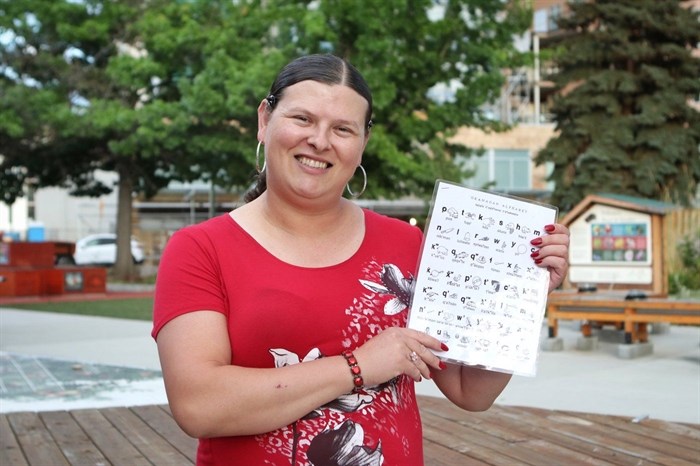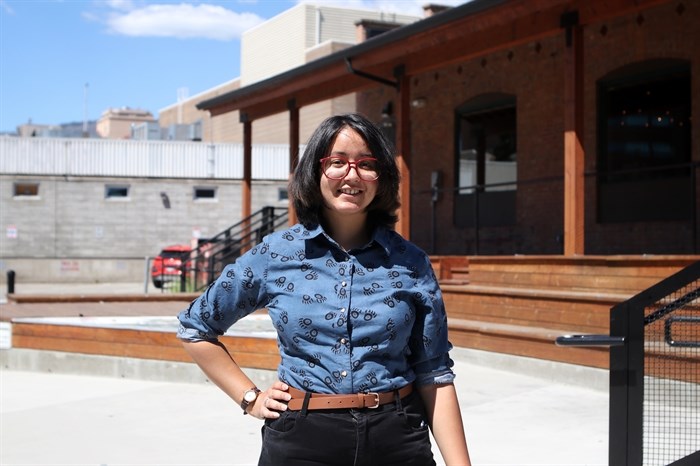
xatma sqilx? Jasmine Peone, a Westbank First Nation (WFN) member and syilx knowledge holder, holds up a copy of the nsyilxc?n alphabet outside of Kelowna Museums’ outdoor classroom at Laurel Square in ki?láwna? (Kelowna) in syilx homelands on Aug. 4, 2022. Peone is partnering with Kelowna Museums to teach the “nsyilxc?n for Everyone” beginner language course.
Image Credit: Photo by Aaron Hemens
August 10, 2022 - 11:02 AM
In an effort to help preserve nsyilxc?n, the language spoken by syilx people, and to promote the nation’s unique teachings, Kelowna Museums is offering a four-week-long nsyilxc?n introductory language course in August.
Once a week for one hour, until Aug. 25, Indigenous and non-Indigenous people gather at the museum’s outdoor classroom at Laurel Square in ki?láwna? (Kelowna) in syilx homelands to learn basic nsyilxc?n vocabulary, pronunciations, place names and greetings.
A partnership between Kelowna Museums and Wildrose Native Traditions, the course is being taught by xatma sqilx? Jasmine Peone, a Westbank First Nation (WFN) member and syilx knowledge holder. According to the syilx Language House, the language is “critically ‘endangered’ with fewer than 40 fluent Elders, and only a few handfuls of intermediate-advanced speakers.”
Peone, who was a student at the syilx Language House, added that the Kelowna Museums’ course also serves to promote allyship with non-Indigenous people. The museum offered the course for the first time pre-pandemic and has now brought it back for a second time.
“By having these courses, by working with the public in teaching them some very basic aspects of our language and culture, it builds some of that appreciation and gives some of the settlers an opportunity to be able to engage with us,” she said.
“To get to know us and be able to appreciate the beauty of our culture and who we are, some of the knowledge and wisdom that’s contained in and embedded in our language and culture.”
As a beginner course, participants are not expected to walk away with the ability to hold a conversation in nsyilxc?n. However, the course gives participants the opportunity to not only learn nsyilxc?n characters and letters, but to also gain a deeper understanding of the cultural significance of each word. Participants are also learning about a number of different syilx values, such as captik?l, which are a collection of syilx teachings about laws, customs and principles.
Peone highlighted that a lot of syilx teachings, wisdom and worldview are embedded in nsyilxc?n.
“It doesn’t translate the same in English,” said Peone. “Our worldview is just very unique, and our language really embodies that.”
For example, the English translation for ksl?slip? is “to gather firewood,” and kl?m?l?m?x?qinm translates to “to sing a love song.” sisyús is defined as “good at doing things,” and nqlqilx?cn” translates “to speak an Indigenous language.”
Alana Firedancer, the Indigenous programming assistant at Kelowna Museums who’s assisting Peone in delivering the course, echoed Peone’s sentiments, emphasizing how intertwined language and culture are.
“There’s some cultural bits that can only be described through language. So many of (syilx) words are packed with cultural meanings,” said Firedancer, who is Cree and Mètis.
“If you don’t know the language, you’re missing out on a big portion of the culture.”

Alana Firedancer, the Indigenous programming assistant at Kelowna Museums, stands near the museum’s outdoor classroom at Laurel Square in ki?láwna? (Kelowna) in syilx homelands on July 26. Firedancer, who is Cree and Mètis, will help facilitate the museum’s “nsyilxc?n for Everyone” outdoor language course.
Image Credit: Photo by Aaron Hemens
In working with the syilx community, Linda Digby, executive director of Kelowna Museums, said that Elders and knowledge holders have shared the importance of land and language as critical to their understanding of self.
“I’ve heard from a number of individuals from the syilx community an invitation for us to be part of that process of mobilizing the language – helping to spread it more widely,” said Digby.
“They’ve told me they need all the allies they can get to help with that purpose. It’s bigger than can be done in community; it has to be a shared purpose.”
Both Peone and Firedancer noted that there is a growing interest from non-Indigenous people to participate in the program.
“Teaching the public helps to create allies and awareness. The more of that we have, the more people we have that support us and unite with us, support initiatives that we’re carrying out,” said Peone.
“I think that’s all important for preserving the language and ensuring that it survives.”
If there is enough interest, Firedancer said that the museum may host a beginner-level part two. Tickets for all of the museum’s learning programs, including the language lessons, are free for Indigenous people.
“Many Indigenous languages have gone ‘extinct’ because of the result of violent colonization in years of residential schools,” said Firedancer. “Now that the greater Canadian public is starting to become more aware of these atrocities, there’s a lot more interest in preserving these languages.”
For Peone, she said that she hopes that participants, especially those who are non-Indigenous, walk away from the course with a newfound understanding and appreciation of how sophisticated Indigenous cultures, knowledge systems and understandings are.
“At the same time, how simple, how humble and balanced they can be,” she said.
“I really hope they take away some deepened or heightened interest in our languages and cultures. I hope that at least some of the folks that take this program will look at how they can positively contribute to language and cultural revitalization in the future.”
— This story was originally published by The Discourse and Indiginews.
News from © iNFOnews, 2022